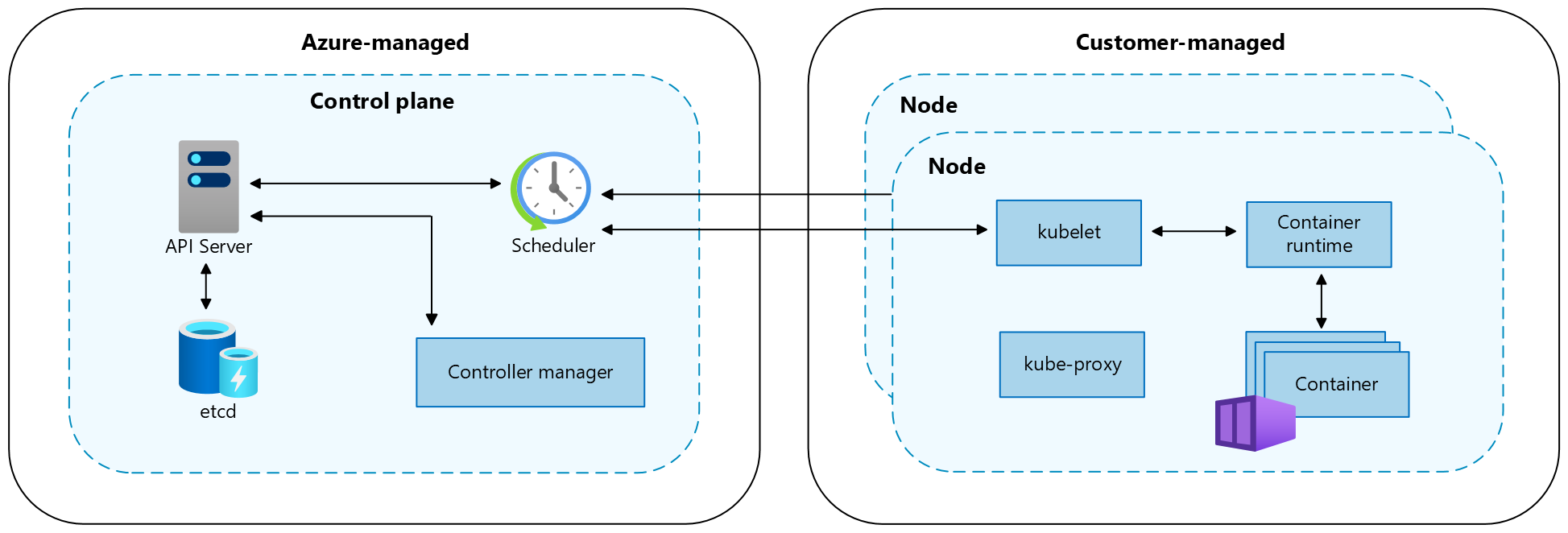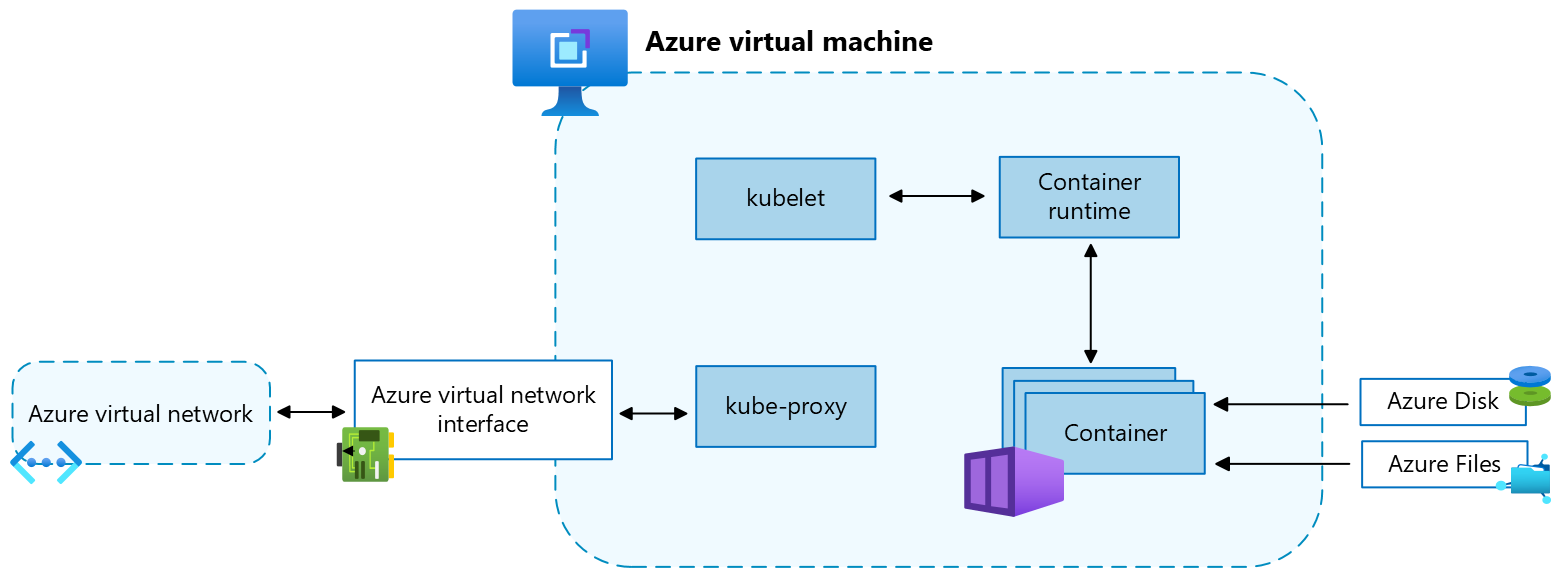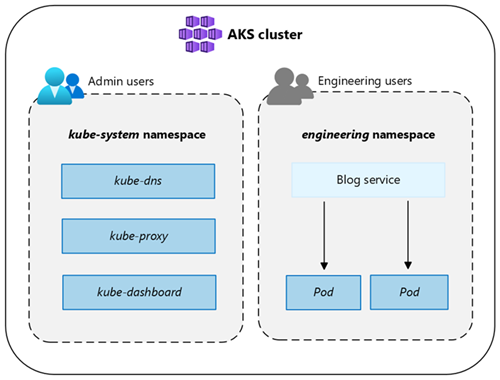Avvenimenti
Ibni Applikazzjonijiet u Aġenti tal-AI
Mar 17, 9 PM - Mar 21, 10 AM
Ingħaqad mas-serje meetup biex tibni soluzzjonijiet skalabbli tal-IA bbażati fuq każijiet ta 'użu fid-dinja reali ma' żviluppaturi u esperti sħabi.
Irreġistra issaDan il-brawżer m'għadux appoġġjat.
Aġġorna għal Microsoft Edge biex tieħu vantaġġ mill-aħħar karatteristiċi, aġġornamenti tas-sigurtà, u appoġġ tekniku.
This article describes core concepts of Azure Kubernetes Service (AKS), a managed Kubernetes service that you can use to deploy and operate containerized applications at scale on Azure.
Kubernetes is an open-source container orchestration platform for automating the deployment, scaling, and management of containerized applications. For more information, see the official Kubernetes documentation.
AKS is a managed Kubernetes service that simplifies deploying, managing, and scaling containerized applications using Kubernetes. For more information, see What is Azure Kubernetes Service (AKS)?
An AKS cluster is divided into two main components:

Nota
AKS managed components have the label "kubernetes.azure.com/managedby": "aks".
AKS manages the Helm releases with the prefix aks-managed. Continuously increasing revisions on these releases are expected and safe.
The Azure managed control plane is composed of several components that help manage the cluster:
| Component | Description |
|---|---|
| kube-apiserver | The API server (kube-apiserver) exposes the Kubernetes API to enable requests to the cluster from inside and outside of the cluster. |
| etcd | etcd is a highly available key-value store that helps maintain the state of your Kubernetes cluster and configuration. |
| kube-scheduler | The scheduler (kube-scheduler) helps make scheduling decisions, watching for new pods with no assigned node and selecting a node for them to run on. |
| kube-controller-manager | The controller manager (kube-controller-manager) runs controller processes, such as noticing and responding when nodes go down. |
| cloud-controller-manager | The cloud controller manager (cloud-controller-manager) embeds cloud-specific control logic to run controllers specific to the cloud provider. |
Each AKS cluster has at least one node, which is an Azure virtual machine (VM) that runs Kubernetes node components. The following components run on each node:
| Component | Description |
|---|---|
| kubelet | The kubelet ensures that containers are running in a pod. |
| kube-proxy | The kube-proxy is a network proxy that maintains network rules on nodes. |
| container runtime | The container runtime manages the execution and lifecycle of containers. |

The Azure VM size for your nodes defines CPUs, memory, size, and the storage type available, such as high-performance SSD or regular HDD. The VM size you choose depends on the workload requirements and the number of pods you plan to run on each node. For more information, see Supported VM sizes in Azure Kubernetes Service (AKS).
In AKS, the VM image for your cluster's nodes is based on Ubuntu Linux, Azure Linux, or Windows Server 2022. When you create an AKS cluster or scale out the number of nodes, the Azure platform automatically creates and configures the requested number of VMs. Agent nodes are billed as standard VMs, so any VM size discounts, including Azure reservations, are automatically applied.
Default OS disk sizing is only used on new clusters or node pools when a default OS disk size isn't specified. This applies to both Managed and Ephemeral OS disks. For more information, see Default OS disk sizing.
AKS uses node resources to help the nodes function as part of the cluster. This usage can cause a discrepancy between the node's total resources and the allocatable resources in AKS. To maintain node performance and functionality, AKS reserves two types of resources, CPU and memory, on each node. For more information, see Resource reservations in AKS.
AKS supports Ubuntu 22.04 and Azure Linux 2.0 as the node OS for Linux node pools. For Windows node pools, AKS supports Windows Server 2022 as the default OS. Windows Server 2019 is being retired after Kubernetes version 1.32 reaches end of life and isn't supported in future releases. If you need to upgrade your Windows OS version, see Upgrade from Windows Server 2019 to Windows Server 2022. For more information on using Windows Server on AKS, see Windows container considerations in Azure Kubernetes Service (AKS).
A container runtime is software that executes containers and manages container images on a node. The runtime helps abstract away sys-calls or OS-specific functionality to run containers on Linux or Windows. For Linux node pools, containerd is used on Kubernetes version 1.19 and higher. For Windows Server 2019 and 2022 node pools, containerd is generally available and is the only runtime option on Kubernetes version 1.23 and higher.
A pod is a group of one or more containers that share the same network and storage resources and a specification for how to run the containers. Pods typically have a 1:1 mapping with a container, but you can run multiple containers in a pod.
In AKS, nodes of the same configuration are grouped together into node pools. These node pools contain the underlying virtual machine scale sets and virtual machines (VMs) that run your applications. When you create an AKS cluster, you define the initial number of nodes and their size (SKU), which creates a system node pool. System node pools serve the primary purpose of hosting critical system pods, such as CoreDNS and konnectivity. To support applications that have different compute or storage demands, you can create user node pools. User node pools serve the primary purpose of hosting your application pods.
For more information, see Create node pools in AKS and Manage node pools in AKS.
When you create an AKS cluster in an Azure resource group, the AKS resource provider automatically creates a second resource group called the node resource group. This resource group contains all the infrastructure resources associated with the cluster, including virtual machines (VMs), virtual machine scale sets, and storage.
For more information, see the following resources:
Kubernetes resources, such as pods and deployments, are logically grouped into namespaces to divide an AKS cluster and create, view, or manage access to resources.
The following namespaces are created by default in an AKS cluster:
| Namespace | Description |
|---|---|
| default | The default namespace allows you to start using cluster resources without creating a new namespace. |
| kube-node-lease | The kube-node-lease namespace enables nodes to communicate their availability to the control plane. |
| kube-public | The kube-public namespace isn't typically used, but can be used for resources to be visible across the whole cluster by any user. |
| kube-system | The kube-system namespace is used by Kubernetes to manage cluster resources, such as coredns, konnectivity-agent, and metrics-server. |

In AKS, you can create a cluster with the Automatic (preview) or Standard mode. AKS Automatic provides a more fully managed experience, managing cluster configuration, including nodes, scaling, security, and other preconfigured settings. AKS Standard provides more control over the cluster configuration, including the ability to manage node pools, scaling, and other settings.
For more information, see AKS Automatic and Standard feature comparison.
AKS offers three pricing tiers for cluster management: Free, Standard, and Premium. The pricing tier you choose determines the features available for managing your cluster.
For more information, see Pricing tiers for AKS cluster management.
For more information, see Supported Kubernetes versions in AKS.
For information on more core concepts for AKS, see the following resources:
Feedback ta’ Azure Kubernetes Service
Azure Kubernetes Service huwa proġett b’sors miftuħ. Agħżel link biex tipprovdi l-feedback:
Avvenimenti
Ibni Applikazzjonijiet u Aġenti tal-AI
Mar 17, 9 PM - Mar 21, 10 AM
Ingħaqad mas-serje meetup biex tibni soluzzjonijiet skalabbli tal-IA bbażati fuq każijiet ta 'użu fid-dinja reali ma' żviluppaturi u esperti sħabi.
Irreġistra issaTaħriġ
Mogħdija tat-tagħlim
Introduction to Kubernetes on Azure - Training
Learn about the basics of Docker containers, container orchestration with Kubernetes, and managed clusters on Azure Kubernetes Service.
Ċertifikazzjoni
Microsoft Certified: Azure Fundamentals - Certifications
Demonstrate foundational knowledge of cloud concepts, core Azure services, plus Azure management and governance features and tools.